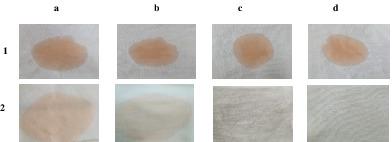当前位置:
X-MOL 学术
›
J. Surfactants Deterg.
›
论文详情
Our official English website, www.x-mol.net, welcomes your
feedback! (Note: you will need to create a separate account there.)
Production of a halotolerant lipase from Halomonas sp. strain C2SS100: Optimization by response-surface methodology and application in detergent formulations
Journal of Surfactants and Detergents ( IF 1.6 ) Pub Date : 2021-12-23 , DOI: 10.1002/jsde.12563 Marwa Khmaissa 1 , Bilel Hadrich 2 , Mohamed Chamkha 3 , Adel Sayari 1 , Ahmed Fendri 1
Journal of Surfactants and Detergents ( IF 1.6 ) Pub Date : 2021-12-23 , DOI: 10.1002/jsde.12563 Marwa Khmaissa 1 , Bilel Hadrich 2 , Mohamed Chamkha 3 , Adel Sayari 1 , Ahmed Fendri 1
Affiliation

|
The aim of this work was to optimize the production of a new lipase by a halotolerant bacterial strain Halomonas sp. C2SS100, by means of the response-surface methodology (RSM). The process parameters having the most significant effect on lipase production were identified using the Plackett–Burman screening design-of-experiments. Then, Box–Behnken design was applied to optimize lipase activity and the quadratic regression model of the lipase production was built. Indeed, the lipase yield was increased, and the value obtained experimentally (39 ± 2 U/ml) was very close to the rate predicted by the model (40.3 U/ml). Likewise, optimization of parameters by RSM resulted in 2.78-fold increase in lipase activity. These findings provide the first report on lipase production and optimization by a halotolerant bacterial strain belonging to Halomonas genus. Afterward, the biochemical properties of the produced lipase were studied for apply in oil stains removal. The crude lipase showed a maximum activity at 60°C and at pH ranging from 7 to 10. It displayed an important stability at high temperature, pH, and NaCl. Interestingly, this bacterial lipase exhibited a prominent stability toward some commercial solid and liquid detergents after 30 min of incubation at 50°C. The capability of the crude lipase to eliminate stain was ascertained on polycotton fabric pieces stained with lubricating oil. Whether with the addition of hot water alone or of a commercially available detergent, lipase is able to considerably boost the elimination of oil stains. The actual findings highlight the capacity of Halomonas sp. lipase for energy-efficient biocatalytic application.
中文翻译:

从 Halomonas sp. 生产耐盐脂肪酶。菌株 C2SS100:响应面法优化和在洗涤剂配方中的应用
这项工作的目的是优化耐盐细菌菌株Halomonas的新脂肪酶的生产。sp。C2SS100,通过响应面方法 (RSM)。使用 Plackett-Burman 筛选实验设计确定了对脂肪酶生产具有最显着影响的工艺参数。然后,应用Box-Behnken设计优化脂肪酶活性,建立了脂肪酶生产的二次回归模型。事实上,脂肪酶产量增加了,实验获得的值(39 ± 2 U/ml)非常接近模型预测的速率(40.3 U/ml)。同样,通过 RSM 优化参数导致脂肪酶活性增加 2.78 倍。这些发现提供了关于由属于Halomonas的耐盐细菌菌株生产和优化脂肪酶的第一份报告属。随后,研究了生产的脂肪酶的生化特性,用于去除油渍。粗脂肪酶在 60°C 和 7 至 10 的 pH 值范围内表现出最大活性。它在高温、pH 值和 NaCl 下表现出重要的稳定性。有趣的是,在 50°C 下孵育 30 分钟后,这种细菌脂肪酶对一些商业固体和液体洗涤剂表现出显着的稳定性。在用润滑油染色的聚棉织物片上确定粗脂肪酶消除污渍的能力。无论是单独添加热水还是添加市售清洁剂,脂肪酶都能够显着促进油渍的消除。实际发现突出了Hamonas sp. 的能力。用于节能生物催化应用的脂肪酶。
更新日期:2021-12-23
中文翻译:

从 Halomonas sp. 生产耐盐脂肪酶。菌株 C2SS100:响应面法优化和在洗涤剂配方中的应用
这项工作的目的是优化耐盐细菌菌株Halomonas的新脂肪酶的生产。sp。C2SS100,通过响应面方法 (RSM)。使用 Plackett-Burman 筛选实验设计确定了对脂肪酶生产具有最显着影响的工艺参数。然后,应用Box-Behnken设计优化脂肪酶活性,建立了脂肪酶生产的二次回归模型。事实上,脂肪酶产量增加了,实验获得的值(39 ± 2 U/ml)非常接近模型预测的速率(40.3 U/ml)。同样,通过 RSM 优化参数导致脂肪酶活性增加 2.78 倍。这些发现提供了关于由属于Halomonas的耐盐细菌菌株生产和优化脂肪酶的第一份报告属。随后,研究了生产的脂肪酶的生化特性,用于去除油渍。粗脂肪酶在 60°C 和 7 至 10 的 pH 值范围内表现出最大活性。它在高温、pH 值和 NaCl 下表现出重要的稳定性。有趣的是,在 50°C 下孵育 30 分钟后,这种细菌脂肪酶对一些商业固体和液体洗涤剂表现出显着的稳定性。在用润滑油染色的聚棉织物片上确定粗脂肪酶消除污渍的能力。无论是单独添加热水还是添加市售清洁剂,脂肪酶都能够显着促进油渍的消除。实际发现突出了Hamonas sp. 的能力。用于节能生物催化应用的脂肪酶。










































 京公网安备 11010802027423号
京公网安备 11010802027423号